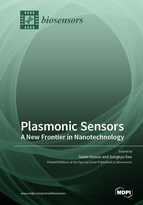Plasmonic Sensors: A New Frontier in Nanotechnology
A special issue of Biosensors (ISSN 2079-6374). This special issue belongs to the section "Optical and Photonic Biosensors".
Deadline for manuscript submissions: closed (31 January 2023) | Viewed by 37434
Special Issue Editors
Interests: nano/bio-photonics; SERS; nanofabrication; bio/chemical sensors
Special Issues, Collections and Topics in MDPI journals
Interests: bio photonics; sensor system; bio sensor; bioelectronics
Special Issues, Collections and Topics in MDPI journals
Special Issue Information
Dear Colleagues,
We are pleased to invite contributions to this Special Issue covering Plasmonic Sensors: A New Frontier in Nanotechnology. Plasmonics is the study of surface plasmons produced by the coupling of incident light with electrons, forming a wave that is bound to the surface of the metal. The intense fields created by plasmons can dramatically enhance various light–matter interactions such as surface-enhanced Raman scattering (SERS) and lead to significant localized heating in metallic nanostructures, known as thermoplasmonics. Plasmonics has found its applications in nanotechnology, biophotonics, sensing, biochemistry, and medicine. This Special Issue of Biosensors focuses on the theory and fabrication of plasmonic nanostructures, patterned surfaces, and devices for bio-sensing applications (such as photothermal conversion), surface plasmon resonance (SPR), surface-enhanced fluorescence (SEF), total internal reflection (TIR), and SERS-based biosensors.
- We welcome contributions to this Special Issue in the form of reviews, full-length articles, and communications. Possible topics include, but are not limited to:
- Fabrication of novel plasmonic nanomaterials with intriguing properties for nanoplasmonics and nanophotonic sensors;
- Hybrid plasmonic nanoparticles and chiral plasmonic nanoparticles;
- 2D transition metal dichalcogenides (TMDCs) material monolayers for biosensing applications;
- Thermoplasmonics and optofluidics biosensors;
- Applications in micro- and nanodevices, as well as materials and biomedical sciences
Dr. Samir Kumar
Prof. Dr. Sungkyu Seo
Guest Editors
Manuscript Submission Information
Manuscripts should be submitted online at www.mdpi.com by registering and logging in to this website. Once you are registered, click here to go to the submission form. Manuscripts can be submitted until the deadline. All submissions that pass pre-check are peer-reviewed. Accepted papers will be published continuously in the journal (as soon as accepted) and will be listed together on the special issue website. Research articles, review articles as well as short communications are invited. For planned papers, a title and short abstract (about 100 words) can be sent to the Editorial Office for announcement on this website.
Submitted manuscripts should not have been published previously, nor be under consideration for publication elsewhere (except conference proceedings papers). All manuscripts are thoroughly refereed through a single-blind peer-review process. A guide for authors and other relevant information for submission of manuscripts is available on the Instructions for Authors page. Biosensors is an international peer-reviewed open access monthly journal published by MDPI.
Please visit the Instructions for Authors page before submitting a manuscript. The Article Processing Charge (APC) for publication in this open access journal is 2700 CHF (Swiss Francs). Submitted papers should be well formatted and use good English. Authors may use MDPI's English editing service prior to publication or during author revisions.
Keywords
- SERS
- plasmonics
- thermoplasmonics
- optofluidics
- sensors
- biophotonics







